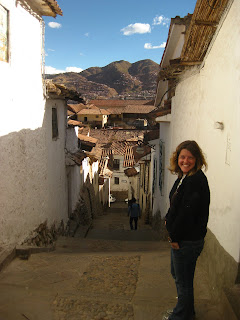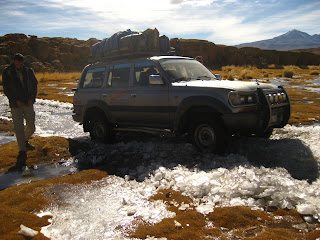The city was colorful and crowded. We spent most of our time just walking around, looking at all the markets and vendors. Some of the vendors were clearly aimed at tourists, while others were aimed at—I’m not sure—elephants, perhaps?


Apparently safety isn’t a huge priority in La Paz. To fix the power lines (of which there were many), the workers just walked into the middle of the street, leaned a ladder against the wires, and climbed up.

We took a day-trip outside La Paz and visited Tiwanaku, an archeological site that dates back to about 1500 BC. The site has been heavily restored, though, so it’s hard to tell what’s old and what’s new.


After a few days in La Paz, we made our way to a Bolivian city called Copacabana, which is on Lake Titicaca. (Fun fact: the famous neighborhood in Rio de Janeiro is named after this city.)

August 6 was Bolivia’s independence day, so the city was packed with revelers. Consequently, the streets were filled with garbage and the not-so-faint smell of urine. To escape the odors, we rented a ridiculous-looking pedal boat and cruised around Lake Titicaca for a while. The city was much nicer from a distance.


We also took a day-trip to Isla del Sol (Island of the Sun). It was a pretty rustic place, with several traditional villages.


After Copacabana, we headed to Peru. Our first stop was a city called Puno, which is also on Lake Titicaca. In Puno, for the first time in South America, I got sick. (Sick as in “I can’t keep my dinner down,” not “I have a stuffy nose.”) I think it must have been the ice cubes in my drink that evening; every other night we’ve had either wine, beer, soda, or water—all of which are packaged in bottles. When you order a cocktail, on the other hand, there’s no telling where the ice cubes came from. I spent most of the night in the bathroom, shivering. I didn’t get sick the next day, but I still felt pretty miserable. Lesson learned: no cocktails.
I was feeling better by the time we got to Cuzco, the former Inca capital. These days it’s more of a tourist capital, but it’s still quite lovely.


Next we headed to a little village called Ollantaytambo (don’t bother trying to pronounce it correctly). The streets couldn’t have been much narrower. Outside of town, on the side of a mountain, there’s an old Inca fortress.


A trip to Peru wouldn’t be complete without a visit to Machu Picchu. It was just as spectacular as I’d imagined.


Now we’re back in Cuzco for a couple days, just relaxing. We’ll head to Lima on Monday and then fly home on Tuesday. The trip has definitely been a blast, but we’re both looking forward to getting home!












